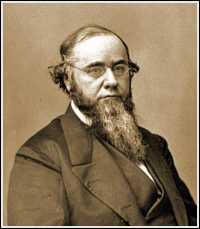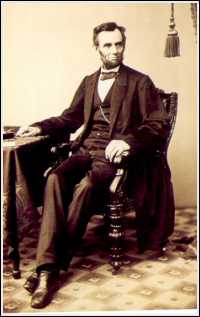 Edwin Stanton was born on December 19, 1814 in Stuebenville, Ohio,
the first child of David and Lucy (Norman) Stanton who enforced
their devout Methodist religious life on their four children.
Edwin Stanton was born on December 19, 1814 in Stuebenville, Ohio,
the first child of David and Lucy (Norman) Stanton who enforced
their devout Methodist religious life on their four children.
* Next Chapter >
*** Quote ***
 Edwin Stanton was born on December 19, 1814 in Stuebenville, Ohio,
the first child of David and Lucy (Norman) Stanton who enforced
their devout Methodist religious life on their four children.
Edwin Stanton was born on December 19, 1814 in Stuebenville, Ohio,
the first child of David and Lucy (Norman) Stanton who enforced
their devout Methodist religious life on their four children.
Ten years later Edwin suffered a asthmatic seizure that tortured him the rest of his life, sometimes to the point of convulsions. Every breath for him became a struggle and probably contributed to his arrogance in later life. On December 30, 1827 David Stanton died, Edwin was apprenticed to a bookseller James Turnbell. At Turnbell's store Stanton would get so engrossed in a book he would sometimes neglect the customers. The Turnbell's accepted Edwin's illnesses and his love of books and reading and allowed him to attend Latin School in the evenings. He worked three years at the book store. Securing a financial loan from a friend of his father, sixteen year Stanton left Steubenville for the first time in his life in 1830 to attend Kenyon College in Gambier, Ohio. At Kenyon College in addition to his studies Stanton took his turn working in the fields and on the road. The founder of the college, Bishop Philander Chase worked his students hard as was attested to by his nephew Salmon P. Chase, 'Uncle Philander expected every boy to do "most of whatever a boy could do on a farm." Financial hardships back in Stuebenville forced Stanton to withdraw from Kenyon two years later and return to Turnbull's bookstore.
In the summer of 1833 cholera swept through eastern Ohio. A
young lady Stanton had a warm friendship with, Ann Howard, the
daughter of Stanton's landlord at his boarding house, served
him dinner at the boarding house. Stanton returned to the bookstore.
One hour later Ann collapsed, by 4 p.m. she was dead. Her family
fearing contamination from the plague buried her immediately.
When Stanton heard of this he was convinced that she had been
buried alive. A young medical student, another boarder of the
rooming house and Stanton by lamplight exhumed the coffin of the
young lady and at the risk of contamination by the deadly disease
Stanton examined the girl and made certain she had not been buried
alived.
Stanton studied law under his mother's lawyer Daniel L. Collier. A few months short of his twenty first birthday in August 1835 Stanton passed the bar exam in St. Clairville. Still under age he could not practice law so Collier gave him the responsibility for preparing court cases.
After his birthday in December Stanton moved to Cadiz, formed a partnership with Chauncy Dewey and on May 31, 1836 on the 'happiest' day of his life married Mary Lamson. In 1838 he moved back to Steubenville.
The partnership with Dewey dissolved and Stanton soon became partners with Judge Benjamin Tappen, a rising star in the Democratic party. Elected to the United States Senate Tappen turned over the bulk of his practice to Stanton.
Stanton became active in the Cadiz Anti-slavery Society in 1837. His first child Lucy was born the same year. She would die in 1841 sending Stanton in the first of his deep depressions. Running as a Deomcratic Stanton was elected Prosecuting Attorney of Harrison County in 1837.
As a lawyer Stanton enjoyed being the defender of justice especially when the villains were the Whigs or Democrats.
The birth of a son Edwin Lamson Stanton in August displaced the grief of Lucy's death. During that winter Stanton became acquainted with a young idealist Cincinnati lawyer. Salmon P. Chase, was convinced that a third political party needed to be formed to work effectively to overthrow slavery. The opponents of slavery could gain the balance of power and then throw it's support to whichever party promised to take a anti-slavery stand. Stanton however tried to convince Chase that the Democratic Party offered the best policies for his anti-slavery efforts and promised to support them if Chase came to over. Neither men convinced the other but Chase and Stanton remained friends for a number of years. It was Chase Stanton in the dark days after his wife Lucy's death in 1844 and his brother Dr. Darwin Stanton's suicide in 1846 turned to. Chase understood Stanton's grieving. He too had suffered great lost. Chase was widowed twice and had buried three young children.
The death of those he loved oppressed Stanton and soon the happy
young man he was turned into a morose brooding man as he turned
a stern face to the world.
In the autumn of 1847 Stanton moved his law practice to Pittsburgh where he
became partners with Charles Shater. Despite his strong feelings against
slavery and his friendship with Chase, Stanton fearing that his support of
the anti-slavery efforts would jeopardize his career refused to openly
support anti-slavery. He was admitted to practice law before the United
States Supreme court in February 1850. In 1850 Stanton had his first
encounter with Abraham Lincoln in a case which
Lincoln was the attorney for the plaintiff in the McCormick Reaper Patent
case. Less than impressed by Lincoln, Stanton and the other counsel for the
 defendant were rude to Lincoln. No one asked the Springfield lawyer to dine
with them although they were all staying at the same hotel. June 1856 Stanton
married for the second time. At forty-one he was wed to twenty-six year old
Ellen Hutchison. Accepted a post in California as a land commissioner in 1857
for two years. Philip Barton Key, United States Attorney for the District of
Columbia was killed by a friend of Stantons in 1859. Key had been having a
romantic affair with the wife of Daniel Sickles. Stanton and co-counsel tried
to prove that in an adulterer maybe be slain with impunity by the wronged man
and at the time of the slaying Sickles was a deranged man and was not
accountable for this actions. It was the first time in American jurisprudence
that a plea of temporary insanity was relied upon. Stanton summing up the
case for the defense, relied heavily on the sanctity of the marriage vows and
a husbands right to keep his home inviolate against seducers. A verdict of
not guilty was returned by the jury. Stanton reluctantly accepted the cabinet
position of Attorney General in President Buchanans administration in 1860.
His private practice was netting him $40,000 that year and promised to
increase, accepting a cabinet post in the lame duck presidents cabinet meant
a personal financial sacrifice for the materialistic Stanton. However his
sense of patriotism was strong. The day Stanton accepted his new position
the flag of the United States descended in South Carolina
defendant were rude to Lincoln. No one asked the Springfield lawyer to dine
with them although they were all staying at the same hotel. June 1856 Stanton
married for the second time. At forty-one he was wed to twenty-six year old
Ellen Hutchison. Accepted a post in California as a land commissioner in 1857
for two years. Philip Barton Key, United States Attorney for the District of
Columbia was killed by a friend of Stantons in 1859. Key had been having a
romantic affair with the wife of Daniel Sickles. Stanton and co-counsel tried
to prove that in an adulterer maybe be slain with impunity by the wronged man
and at the time of the slaying Sickles was a deranged man and was not
accountable for this actions. It was the first time in American jurisprudence
that a plea of temporary insanity was relied upon. Stanton summing up the
case for the defense, relied heavily on the sanctity of the marriage vows and
a husbands right to keep his home inviolate against seducers. A verdict of
not guilty was returned by the jury. Stanton reluctantly accepted the cabinet
position of Attorney General in President Buchanans administration in 1860.
His private practice was netting him $40,000 that year and promised to
increase, accepting a cabinet post in the lame duck presidents cabinet meant
a personal financial sacrifice for the materialistic Stanton. However his
sense of patriotism was strong. The day Stanton accepted his new position
the flag of the United States descended in South Carolina
Unhappy with the president's indecisive actions with the commissioners from South Carolina over the actions taken with regards to Fort Sumter Stanton decided to take his own action. Deciding what was best for the Union he clandestinely became an informer to the Republicans, mainly Senator William H. Seward who informed President-elect Lincoln of what was being done in the white house. In later years Stanton defended himself against criticism that he violated his oath of office with the assertion that he was not only the President's servant but also the servant of the people and had a duty to his country to do so. All the while he not believe that if the war came it would last long.
* Next Chapter >